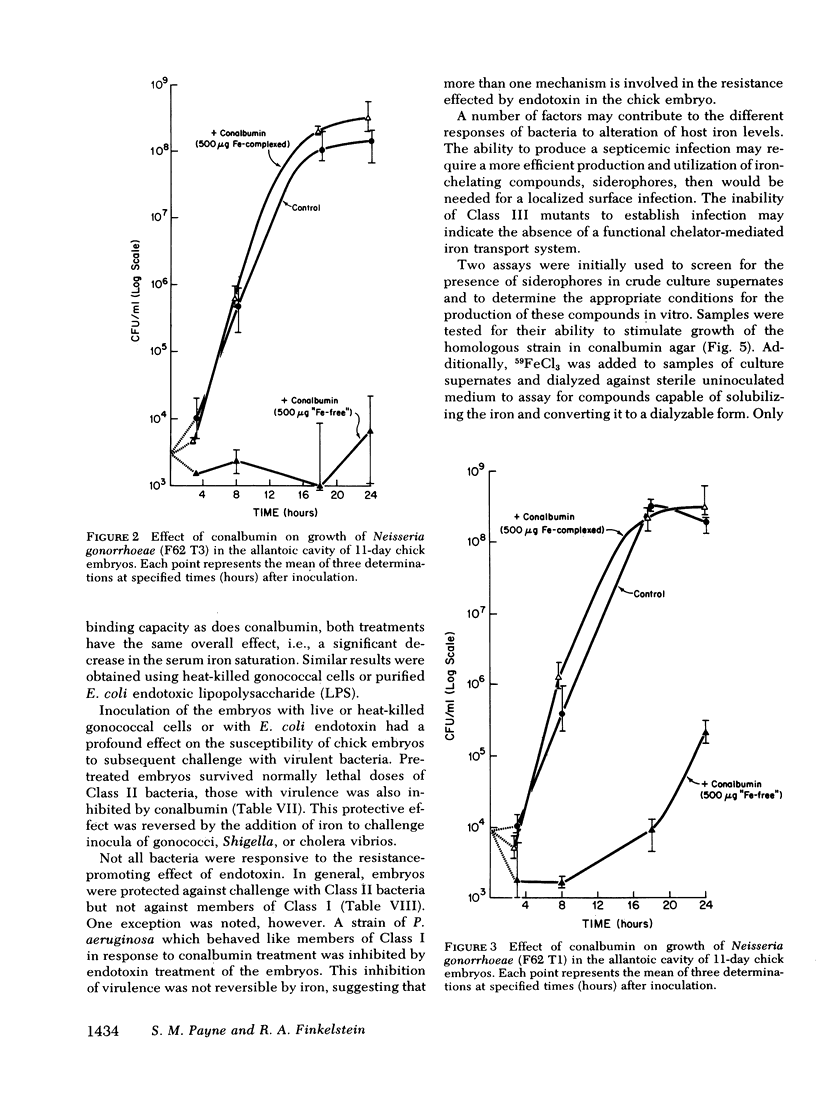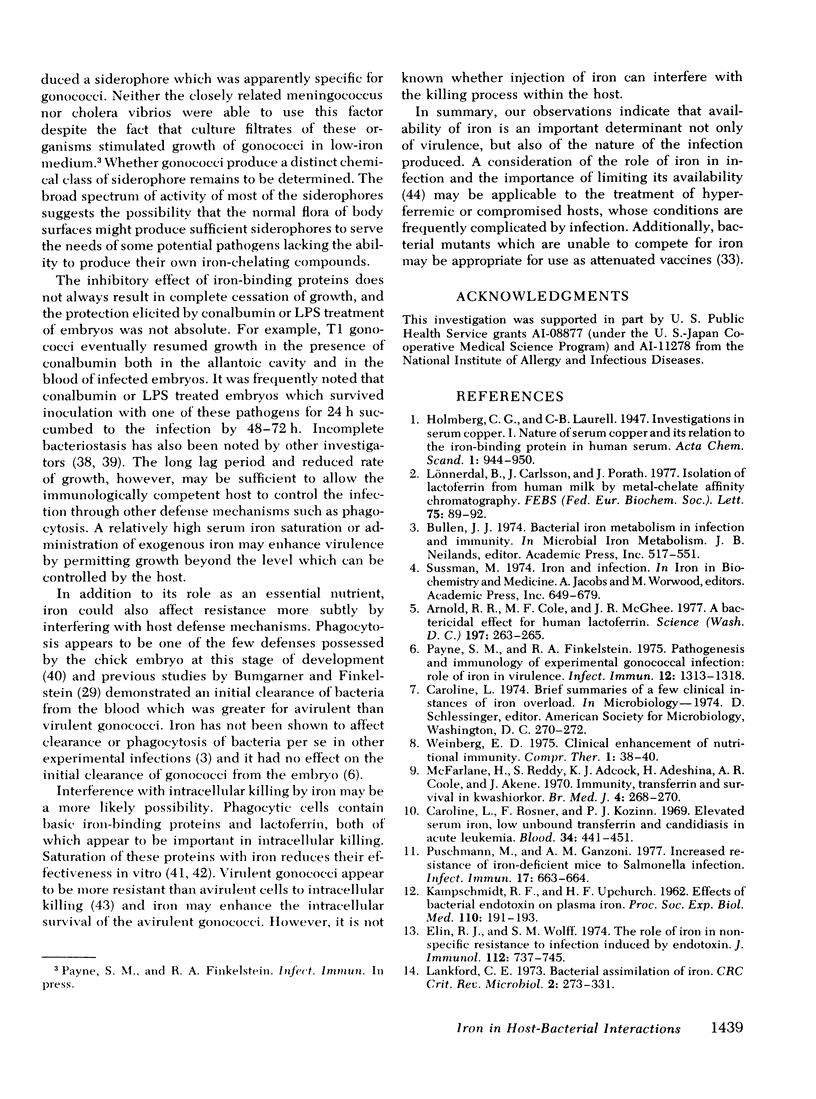Abstract
The ability of potential pathogens to acquire iron in a host is an important determinant of both their virulence and the nature of the infection produced. Virulent gram-negative bacteria are capable of acquiring sufficient iron from the host because their virulence (for chick embryos) is unaffected by exogenous iron. Avirulent mutants which are apparently limited in their ability to acquire iron could be isolated from the virulent strains. The lethality of these mutants was significantly enhanced by exogenous iron. Reduction of the relatively high serum iron saturation of chick embryos (to levels more closely approximating those in man) by pretreatment with iron-binding proteins or endotoxin inhibits the lethality of some virulent bacteria. Those bacteria whose virulence was reduced include the Shigella, Vibrio cholerae and strains of Neisseria gonorrhoeae, all of which are nondisseminating pathogens in the normal human host. Pathogens which produce septicemic and disseminating infections such as Neisseria meningitidis, Haemophilus influenzae type B, Escherichia coli possessing K-1 antigen, Pseudomonas aeruginosa and Salmonella typhimurium and disseminating strains of N. gonorrhoeae were, in general, unaffected by reduced serum iron saturation. These disseminating bacteria appeared to produce greater quantities of compounds (siderophores) which stimulated microbial growth in low-iron media than did the nondisseminating pathogens. Thus, the gram-negative bacteria tested can be divided into four major classes according to their responses to modifications in iron levels in the chick embryo model and these results correlate with the nature of the infections which they typically produce in man.
Full text
PDF












Images in this article
Selected References
These references are in PubMed. This may not be the complete list of references from this article.
- Arnold R. R., Cole M. F., McGhee J. R. A bactericidal effect for human lactoferrin. Science. 1977 Jul 15;197(4300):263–265. doi: 10.1126/science.327545. [DOI] [PubMed] [Google Scholar]
- Board R. G., Fuller R. Non-specific antimicrobial defences of the avian egg, embryo and neonate. Biol Rev Camb Philos Soc. 1974 Feb;49(1):15–49. doi: 10.1111/j.1469-185x.1974.tb01297.x. [DOI] [PubMed] [Google Scholar]
- Bullen J. J., Rogers H. J., Lewin J. E. The bacteriostatic effect of serum on Pasteurella septica and its abolition by iron compounds. Immunology. 1971 Mar;20(3):391–406. [PMC free article] [PubMed] [Google Scholar]
- Bullen J. J., Ward C. G., Wallis S. N. Virulence and the role of iron in Pseudomonas aeruginosa infection. Infect Immun. 1974 Sep;10(3):443–450. doi: 10.1128/iai.10.3.443-450.1974. [DOI] [PMC free article] [PubMed] [Google Scholar]
- Bumgarner L. R., Finkelstein R. A. Pathogenesis and immunology of experimental gonococcal infection: virulence of colony types of Neisseria gonorrhoeae for chicken embryos. Infect Immun. 1973 Dec;8(6):919–924. doi: 10.1128/iai.8.6.919-924.1973. [DOI] [PMC free article] [PubMed] [Google Scholar]
- Carlsson J., Porath J., Lönnerdal B. Isolation of lactoferrin from human milk by metal-chelate affinity chromatography. FEBS Lett. 1977 Mar 15;75(1):89–92. doi: 10.1016/0014-5793(77)80059-8. [DOI] [PubMed] [Google Scholar]
- Caroline L., Rosner F., Kozinn P. J. Elevated serum iron, low unbound transferrin and candidiasis in acute leukemia. Blood. 1969 Oct;34(4):441–451. [PubMed] [Google Scholar]
- Chandler R. W., Rendtorff R. C., Curran J. W., Kellogg D. S., Jr Evaluation of media used for cultures of Neisseria gonorrhoeae and comparison of commercial and laboratory prepared supplements. J Am Vener Dis Assoc. 1974 Sep;1(1):14–19. [PubMed] [Google Scholar]
- Cook J. D., Barry W. E., Hershko C., Fillet G., Finch C. A. Iron kinetics with emphasis on iron overload. Am J Pathol. 1973 Aug;72(2):337–344. [PMC free article] [PubMed] [Google Scholar]
- Elin R. J., Wolff S. M. The role of iron in nonspecific resistance to infection induced by endotoxin. J Immunol. 1974 Feb;112(2):737–745. [PubMed] [Google Scholar]
- FINKELSTEIN R. A. Alteration of susceptibility of embryonated eggs to Newcastle disease virus by Escherichia coli and endotoxin. Proc Soc Exp Biol Med. 1961 Mar;106:481–484. doi: 10.3181/00379727-106-26376. [DOI] [PubMed] [Google Scholar]
- FINKELSTEIN R. A., RANSOM J. P. Non-specific resistance to experimental cholera in embryonated eggs. J Exp Med. 1960 Aug 1;112:315–328. doi: 10.1084/jem.112.2.315. [DOI] [PMC free article] [PubMed] [Google Scholar]
- Finkelstein R. A., Atthasampunna P., Chulasamaya M., Charunmethee P. Pathogenesis of experimental cholera: biologic ativities of purified procholeragen A. J Immunol. 1966 Mar;96(3):440–449. [PubMed] [Google Scholar]
- Frantz I. D. Growth Requirements of the Meningococcus. J Bacteriol. 1942 Jun;43(6):757–761. doi: 10.1128/jb.43.6.757-761.1942. [DOI] [PMC free article] [PubMed] [Google Scholar]
- Gladstone G. P., Walton E. Effect of iron on the bactericidal proteins from rabbit polymorphonuclear leukocytes. Nature. 1970 Aug 22;227(5260):849–851. doi: 10.1038/227849a0. [DOI] [PubMed] [Google Scholar]
- KAMPSCHMIDT R. F., UPCHURCH H. F. Effects of bacteria endotoxin on plasma iron. Proc Soc Exp Biol Med. 1962 May;110:191–193. doi: 10.3181/00379727-110-27463. [DOI] [PubMed] [Google Scholar]
- Kochan I., Cahall D. L., Golden C. A. Employment of tuberculostasis in serum-agar medium for the study of production and activity of Mycobactin. Infect Immun. 1971 Aug;4(2):130–137. doi: 10.1128/iai.4.2.130-137.1971. [DOI] [PMC free article] [PubMed] [Google Scholar]
- Labrec E. H., Schneider H., Magnani T. J., Formal S. B. EPITHELIAL CELL PENETRATION AS AN ESSENTIAL STEP IN THE PATHOGENESIS OF BACILLARY DYSENTERY. J Bacteriol. 1964 Nov;88(5):1503–1518. doi: 10.1128/jb.88.5.1503-1518.1964. [DOI] [PMC free article] [PubMed] [Google Scholar]
- Luckey M., Pollack J. R., Wayne R., Ames B. N., Neilands J. B. Iron uptake in Salmonella typhimurium: utilization of exogenous siderochromes as iron carriers. J Bacteriol. 1972 Sep;111(3):731–738. doi: 10.1128/jb.111.3.731-738.1972. [DOI] [PMC free article] [PubMed] [Google Scholar]
- Macham L. P., Ratledge C. A new group of water-soluble iron-binding compounds from Mycobacteria: the exochelins. J Gen Microbiol. 1975 Aug;89(2):379–382. doi: 10.1099/00221287-89-2-379. [DOI] [PubMed] [Google Scholar]
- Miles A. A., Khimji P. L. Enterobacterial chelators of iron: their occurrence, detection, and relation to pathogenicity. J Med Microbiol. 1975 Nov;8(4):477–490. doi: 10.1099/00222615-8-4-477. [DOI] [PubMed] [Google Scholar]
- Payne S. M., Finkelstein R. A. Detection and differentiation of iron-responsive avirulent mutants on Congo red agar. Infect Immun. 1977 Oct;18(1):94–98. doi: 10.1128/iai.18.1.94-98.1977. [DOI] [PMC free article] [PubMed] [Google Scholar]
- Payne S. M., Finkelstein R. A. Imferon agar: improved medium for isolation of pathogenic Neisseria. J Clin Microbiol. 1977 Sep;6(3):293–297. doi: 10.1128/jcm.6.3.293-297.1977. [DOI] [PMC free article] [PubMed] [Google Scholar]
- Payne S. M., Finkelstein R. A. Pathogenesis and immunology of experimental gonococcal infection: role of iron in virulence. Infect Immun. 1975 Dec;12(6):1313–1318. doi: 10.1128/iai.12.6.1313-1318.1975. [DOI] [PMC free article] [PubMed] [Google Scholar]
- Persijn J. P., van der Slik W., Riethorst A. Determination of serum iron and latent iron-binding capacity (LIBC). Clin Chim Acta. 1971 Nov;35(1):91–98. doi: 10.1016/0009-8981(71)90298-1. [DOI] [PubMed] [Google Scholar]
- Puschmann M., Ganzoni A. M. Increased resistance of iron-deficient mice to salmonella infection. Infect Immun. 1977 Sep;17(3):663–664. doi: 10.1128/iai.17.3.663-664.1977. [DOI] [PMC free article] [PubMed] [Google Scholar]
- Reddy S., Adcock K. J., Adeshina H., Cooke A. R., Akene J., McFAarlane H. Immunity, transferrin, and survival in kwashiorkor. Br Med J. 1970 Oct 31;4(5730):268–270. doi: 10.1136/bmj.4.5730.268. [DOI] [PMC free article] [PubMed] [Google Scholar]
- Rogers H. J. Iron-Binding Catechols and Virulence in Escherichia coli. Infect Immun. 1973 Mar;7(3):445–456. doi: 10.1128/iai.7.3.445-456.1973. [DOI] [PMC free article] [PubMed] [Google Scholar]
- Schade A. L., Caroline L. RAW HEN EGG WHITE AND THE ROLE OF IRON IN GROWTH INHIBITION OF SHIGELLA DYSENTERIAE, STAPHYLOCOCCUS AUREUS, ESCHERICHIA COLI AND SACCHAROMYCES CEREVISIAE. Science. 1944 Jul 7;100(2584):14–15. doi: 10.1126/science.100.2584.14. [DOI] [PubMed] [Google Scholar]
- Weinberg E. D. Clinical enhancement of nutritional immunity. Compr Ther. 1975 Sep;1(5):38–40. [PubMed] [Google Scholar]
- Willard J. M., Davis J. J., Wood H. G. Phosphoenolpyruvate carboxytransphosphorylase. IV. Requirement for metal cations. Biochemistry. 1969 Aug;8(8):3137–3144. doi: 10.1021/bi00836a002. [DOI] [PubMed] [Google Scholar]
- Witt K., Veale D. R., Smith H. Resistance of Neisseria gonorrhoeae to ingestion and digestion by phagocytes of human buffy coat. J Med Microbiol. 1976 Feb;9(1):1–12. doi: 10.1099/00222615-9-1-1. [DOI] [PubMed] [Google Scholar]



